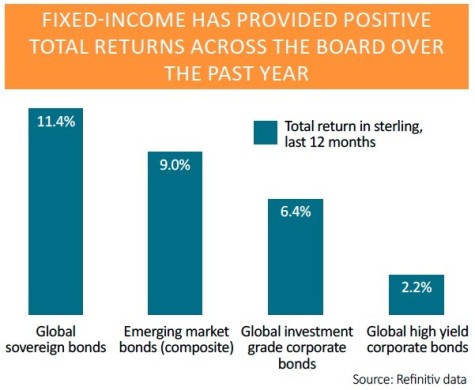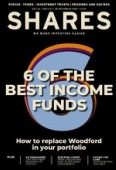Archived article
Please note that tax, investment, pension and ISA rules can change and the information and any views contained in this article may now be inaccurate.
How to read the bond market

For the umpteenth year in a row, bonds have confounded the bears in 2019. Once more, its exposure to the fixed-income asset class has proved its worth, for diversification purposes and for sold total returns.
Yields may not be huge, far from it with the benchmark UK 10-year Gilt offering 0.71% and the US 10-year Treasury 1.76%, but yields are lower than they were a year ago because prices are higher.
There are several possible explanations for this. Concerns over economic growth and buying of ‘haven’ assets as well as fears over the ‘Japanification’ of the West meant that long-dated bonds did particularly well as portfolio-builders pondered whether we are in for years, if not decades, of weak growth, low inflation and low interest rates.
Other factors include central banks’ return to cutting rather than raising interest rates and the ongoing reach for yield in a low-interest-rate world among life insurers (as they seek to match future liabilities with income) and savers.
Also influential has been the return to bond-buying via quantitative easing (QE) by the European Central Bank, ongoing QE in Japan and the US Federal Reserve’s decision to stop shrinking its balance sheet in an attempt to sterilise its QE scheme.
All of these factors create demand – and more than enough demand, it seems, to swamp the supply created by rampant government, corporate and consumer borrowing.
QE programmes lead some to complain that fixed-income markets are ‘broken’ and distorted, even if the amount of bonds on a global basis that come with a negative yield has dropped from a peak of around $17tn to between $12tn and $13tn.
If supply is not apparently a problem, at least for now, then investors need to think about what could stoke or choke off demand.
Know the risks
The major risks associated with investing in bonds, via individual issues or funds, are:
Interest rate risk. If interest rates rise, there may be more attractive yields on offer elsewhere, persuading investors to sell their bonds and migrate to either a different asset class (cash) or bonds issues with higher yields.
Credit risk. This is the risk that the issuer proves unable to pay the coupons (interest) and ultimately repay the whole loan (principal) upon maturity.
Inflation risk. As with cash, inflation reduces the real-terms value of the coupons paid by most bonds (index-linked bonds being an exception).
In sum, a sudden burst of economic growth and inflation would probably be bad for bonds, with the exception of high-yield and possibly emerging-market bonds.
Growth is good for corporate profits and cash flow and makes it easier for firms (or governments) with weak balance sheets to fund their liabilities. This is why high yield trades more like equity (shares) than debt (bonds). The biggest risk for government bonds are interest rate risk and inflation risk (as very few countries actually default, Argentina being an unfortunate serial offender).
The risks for investment-grade corporate debt are probably equally spread between credit risk, interest rate risk and inflation risk.
The biggest risk for high yield debt is credit risk and the danger the issuer goes broke.
A view on interest rates and inflation will largely shape investors’ outlook on government bonds and, to a lesser degree, investment grade corporate bonds. A view on the economy and inflation will shape investors’ outlook on credit risk and therefore high-yield bonds and, also to a degree, investment-grade bonds.
Investors also need to consider the issue of maturity.
Short-term bonds offer less interest rate risk, less credit risk and less inflation risk.
Long-term bonds offer more interest rate risk, more credit risk and more inflation risk, as they have a longer lifespan and there is more scope for things to go wrong. That is why investors generally demand higher yields on longer-term paper, to compensate themselves for the additional dangers.
Yield curve conundrum
This takes us on to the issue of the yield curve. Normally, longer-term bonds offer higher yields but this summer the curve inverted, as benchmarked by the yield gap between two-year and 10-year government bonds in the UK and US.
That is usually taken to be a sign that a downturn or recession is coming, as the market prices in lower interest rates in the future in response to the slowdown.
The good news is the yield curve has steepened and the curve is no longer inverted (the yield on 10 year gilts exceeds that of two-year gilts).
Investors must now assess whether this is either a ‘bull’ steepener, where long-term yields are rising faster than near-term ones (which implies future growth), or a ‘bear’ steepener, where near-term yields fall faster than long-term ones (as that implies an imminent recession and more interest rate cuts).
Note that a sudden steepening of the yield curve was a harbinger of increased volatility (if not outright falls) in UK share prices in 1998, 2000 and 2007, so the yield curve must still be watched, not just for its shape, but how that shape is formed.
Reassuringly, the UK two-year yield is up by 13 basis points from when the curve first inverted and the 10-year is up by 31 basis points. So far, so bullish, but watch this space.
Important information:
These articles are provided by Shares magazine which is published by AJ Bell Media, a part of AJ Bell. Shares is not written by AJ Bell.
Shares is provided for your general information and use and is not a personal recommendation to invest. It is not intended to be relied upon by you in making or not making any investment decisions. The investments referred to in these articles will not be suitable for all investors. If in doubt please seek appropriate independent financial advice.
Investors acting on the information in these articles do so at their own risk and AJ Bell Media and its staff do not accept liability for losses suffered by investors as a result of their investment decisions.

 magazine
magazine











